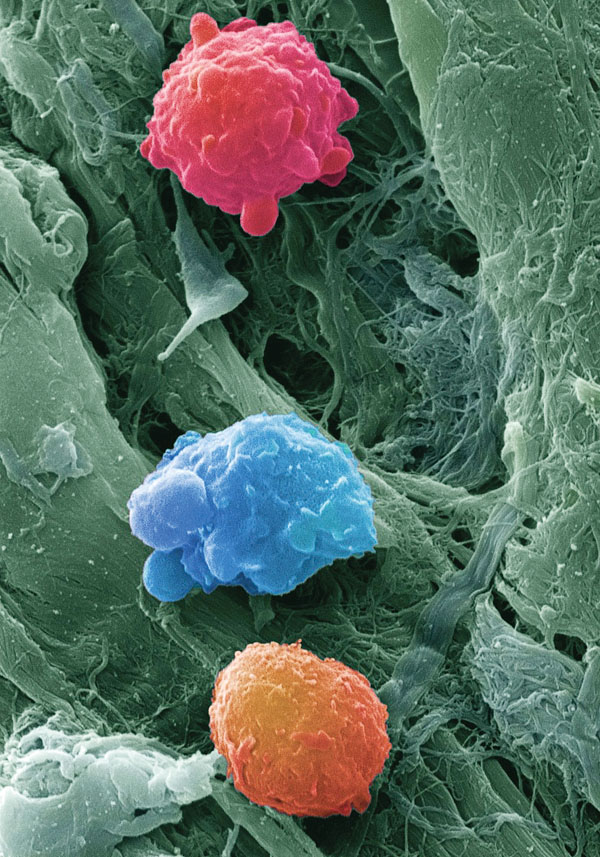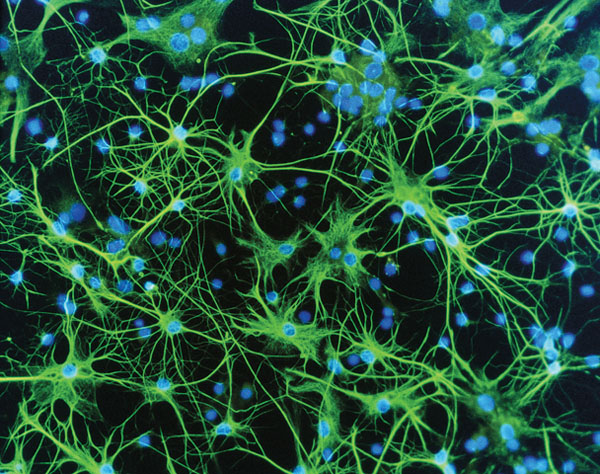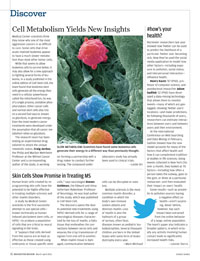Discover
 SLOW METABOLISM: Scientists have found some leukemia cells generate their energy in a different way than previously thought. (Photo: Science Source)
SLOW METABOLISM: Scientists have found some leukemia cells generate their energy in a different way than previously thought. (Photo: Science Source)Medical Center scientists think they know why one of the most aggressive cancers is so difficult to cure. Some cells that drive acute myeloid leukemia appear to have a much slower metabolism than most other tumor cells.
While that seems to allow leukemia cells to survive better, it may also allow for a new approach to fighting several forms of leukemia. In a study published in the online edition of Cell Stem Cell, the team found that leukemia stem cells generate all the energy they need in a cellular powerhouse called the mitochondrion, by way of a single process, oxidative phosphorylation. Other cancer cells and normal stem cells also rely on a second fuel source, known as glycolysis, to generate energy. Even the most modern cancer treatments were developed under the assumption that all cancer metabolism relies on glycolysis.
The research team has been testing an experimental drug tailored to attack the unique metabolic status. Craig Jordan, the Philip and Marilyn Wehrheim Professor at the Wilmot Cancer Center and a corresponding author of the study, is working on forming a partnership with a drug maker to conduct further testing. The compound under laboratory study has already been used in clinical trials.
—Leslie Orr
Skin Cells Show Promise in Treating MS
 SIGNALS: A new look at neurons (Photo: Science Source)
SIGNALS: A new look at neurons (Photo: Science Source)Human brain cells created by reprogramming skin cells have the potential to be highly effective in treating multiple sclerosis and other myelin disorders.
A study by Medical Center scientists is the first successful attempt to use special cells—known technically as human induced pluripotent stem cells, or hiPSC—to produce a population of cells that are critical to neural signaling in the brain.
It “appears that cells derived from this source are at least as effective as those created using embryonic or tissue-specific stem cells,” says neurologist Steven Goldman, the Edward and Alma Vollertsen Rykenboer Professor of Neurology. He was lead author of the study, which was published in Cell Stem Cell.
The discovery opens the door to potential new treatments using hiPSC–derived cells for a range of neurological diseases characterized by the loss of myelin, a fatty tissue that ensheathes the connections between nerve cells and ensures the crisp transmission of signals from one cell to another. When myelin tissue is damaged, communication between cells can be disrupted or even lost.
Multiple sclerosis is the most common myelin disorder, a condition in which the body’s own immune system attacks and destroys myelin. Loss of myelin is also the hallmark of a group of serious, often fatal, diseases known as pediatric leukodystrophies. Several thousand children are born in the United States with some form of leukodystrophy every year.
—Mark Michaud
#how’s your health?
Rochester researchers last year showed how Twitter can be used to predict the likelihood of a particular Twitter user becoming sick. Now they’ve used the social media application to model how other factors—including exposure to pollution, social status, and interpersonal interaction—influence health.
Henry Kautz ’87 (PhD), professor of computer science, and postdoctoral researcher Adam Sadilek ’12 (PhD) have developed a data-mining technology that allows them to monitor tweets—many of which are geotagged, showing Twitter users’ locations—and make predictions. By following thousands of users, researchers can estimate interactions between users and between users and their environment.
At the International Conference on Web Searching and Data Mining in February, Sadilek showed how the new model accounts for many of the factors that affect health and how it can complement traditional studies in life sciences. Using tweets collected in New York City over a month, they looked at 70 factors—including how often a person takes the subway, goes to the gym, or dines at a particular restaurant—and then evaluated their impact on users’ health.
Some results—such as proximity to pollution sources having a negative effect on health—aren’t surprising. Never before, however, has such impact been extracted from the online behavior of a large, online population. The team’s paper also indicates a broader pattern, in which virtually any activity involving human contact leads to significantly increased health risks.
—Leonor Sierra
Model for Brain Signaling Flawed
A new study has overturned a long-accepted understanding of how brain cells communicate. The new work indicates that the tripartite synapse—a model long accepted by the scientific community, in which multiple cells collaborate to move signals in the central nervous system—doesn’t exist in the adult brain.
The longheld concept doesn’t represent the process for transmitting signals between neurons in the brain beyond the developmental stage, say Medical Center scientists in a study published in Science.
Neurons are connected to each other via axons or “arms” that extend from the cell’s main body. Communication between neighboring neurons takes place where axons meet other nerve cells—called a synaptic juncture—when an electrical charge causes chemicals called neurotransmitters or glutamate to be released by one cell and “read” by receptors on the surface of the other. The two cells don’t actually touch, so the chemical messages must pass through a gap in the synaptic juncture. The space around this gap is insulated by glial, or non-neuron, cells known as astrocytes.
Under the tripartite synapse model, both astrocytes and neurons were believed to play a role in the conversation between cells—an understanding based largely on animal models, which showed active receptors and neurotransmitters between not only the nerve cells but also the nearby astrocytes. Scientists believed that they must, in some way, modulate the signaling process between brain cells.
While this model has held sway for decades, scientists have long been frustrated by their inability to influence the process by targeting it with drugs.
Collaborating with researchers at the Institute of Optics, Maiken Nedergaard, lead author of the study and codirector of the Center for Translational Neuromedicine, and her team developed a new 2-photon microscope that enables researchers to observe glial activity in the living brain. They discovered that glial cells don’t directly respond to synaptic neuronal signaling.
The transmission process of the tripartite synapse model “appears to just be a simplistic signaling pathway that ‘teaches’ the synapse how to behave,” Nedergaard says. “Once the brain matures, it goes away.”
—Mark Michaud
Men Are from Earth, Women Are from Earth
For decades, popular writers have entertained readers with the premise that men and women are so psychologically dissimilar they could hail from different planets. But a new study shows it’s time for those theories to come back to Earth.
A Rochester-led analysis of 122 different characteristics—from empathy and sexuality to scientific inclination and extroversion—involving more than 13,000 people shows that men and women, by and large, don’t fall into different groups. In other words, no matter how inscrutable your partner may seem, gender is probably only a small part of the reason.
Instead of clustering at either end of the spectrum—the way scores do with height and physical strength—psychological indicators fall along a linear gradation for both genders. With few exceptions, variability within each sex and overlap between the sexes is so extensive that study authors Harry Reis, professor of psychology, and Bobbi Carothers ’03 (PhD) conclude it would be inaccurate to use personality types, attitudes, or psychological indicators as a sorting scheme.
“Sex is not nearly as confining a category as stereotypes and even some academic studies would have us believe,” says Carothers. The study was published in the Journal of Personality and Social Psychology.
—Susan Hagen

